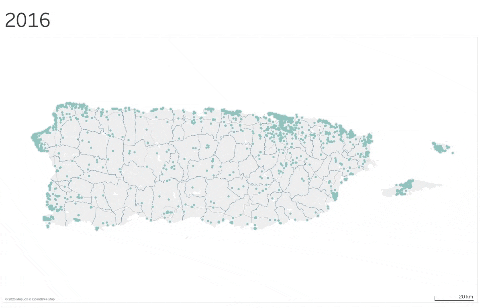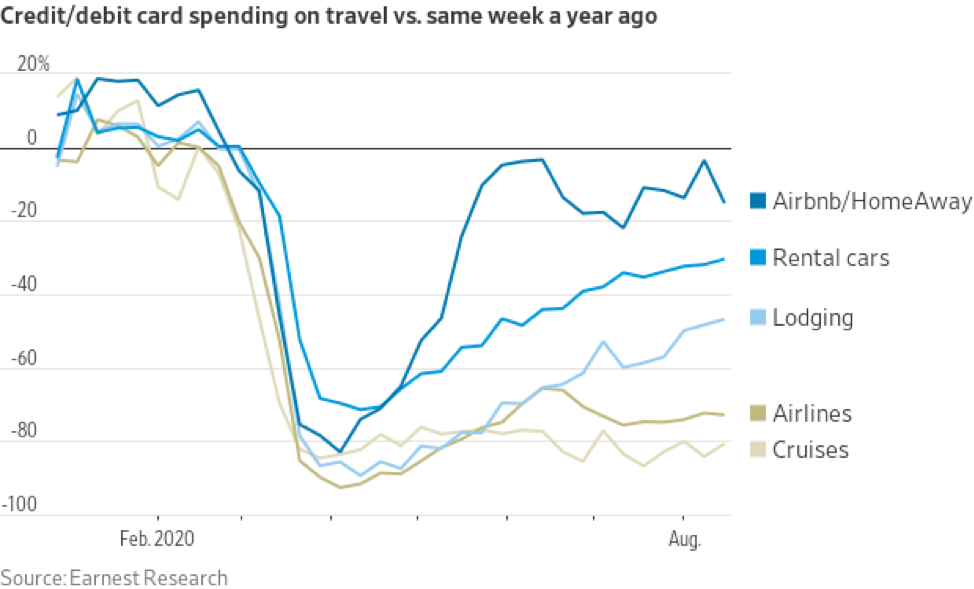
Published on September 3, 2020 / Leer en español
Dear Readers:
As we head into Labor Day weekend, the unofficial end of the summer, it is a good time to take stock of where we are and preview what is coming during the fall.
The COVID-19 pandemic is still with us and, unfortunately, the summer in the U.S. was worse than expected. Major outbreaks were reported in Arizona, Texas, and Florida as the U.S. caseload climbed towards 6 million, while reported deaths exceeded 180,000. On some days in July total deaths reported exceeded 1,400, or approximately 1 death per minute. And while recent data shows the rates of infection, hospitalization, and mortality are trending down in most parts of the U.S., many experts are still worried about the reopening of schools, the lifting of restrictions on economic activity, and the colder weather, which makes social distancing all the more difficult.
Meanwhile, economic activity is still on the downside, as many jurisdictions have dialed back on what turned out to be in hindsight a premature economic reopening. The unemployment rate is still high by postwar historical standards, as are new jobless claims for unemployment insurance. Policy initiatives by the Federal Reserve and Congress helped cushion the economic blow and keep consumer spending and other indicators relatively stable, but in the absence of new economic relief legislation, we can expect further layoffs, increased evictions, especially of renters, more bankruptcies, and increased loan defaults.
All that in addition to political gridlock in Washington, widespread racial strife, intense urban protests, and unprecedented efforts at the federal level to suppress the vote in November.
For now, though, let us enjoy the long weekend. Even as we prepare for the hard, long slog that lies ahead.
—Sergio M. Marxuach, Editor-in-Chief
Insights + Analysis from CNE

Agreement between PREPA and LUMA
By Sergio M. Marxuach, Policy Director
On June 22, 2020, PREPA and the Puerto Rico Public-Private Partnerships Authority (the “P3A” or “Administrator”) entered into an agreement for the Operation and Maintenance (“O&M” Agreement) of PREPA’s Transmission and Distribution System (“T&D System”) with LUMA Energy, LLC, (“ManagementCo”) and LUMA Energy Servco, LLC (“ServCo”, and together with ManagementCo, the “Operator”).
Recently, CNE published a report that analyzes this transaction and offers specific recommendations to improve it. We summarize below some aspects of the agreement that in our opinion raise important concerns.
Power Supply Dispatch and Management
The O&M Agreement requires the Operator to use “economic dispatch” to run the T&D System, but that term is ambiguously defined. The combination of an ambiguous definition of “economic dispatch” and an oligopolistic market structure means that strategic interactions among and between market players, including price-fixing via market signals, could take place and result in rent-seeking behavior and the extraction of rents.
Therefore, the Puerto Rico Energy Bureau (“PREB”) should clarify, by regulation if necessary, the meaning of “economic dispatch” in the Puerto Rico power market, and develop a process to investigate allegations of price-fixing or market collusion.
Benchmarks
To receive payment of the annual Incentive Fee, the Operator has to achieve certain performance benchmarks. But a significant number of the benchmarks has not been determined yet and are subject to further negotiation among the parties. In addition, almost all of the benchmarks are set against PREPA’s prior performance, which sets the bar too low to justify the transaction.
In our opinion, the performance metrics should be developed in consultation with the PREB and the P3A using best practices and benchmarks from similarly situated utilities.
Airbnb and Affordable Housing in Puerto Rico: Possible Cause for Concern
By Raúl Santiago-Bartolomei, Ph.D., Research Associate
As Puerto Rico is still in the midst of the COVID-19 pandemic, and its government is resuming post-disaster reconstruction works, it is important to ensure that households in the island have stable and affordable housing. This requires monitoring and addressing issues that might reduce the affordable housing stock. One issue that has been cause for concern for stakeholders and affordable housing advocates is the prevalence of short-term rentals through digital platforms, such as Airbnb, VRBO, and HomeAway. As part of CNE’s Blueprint Housing and Land Initiative, we have been identifying trends and dynamics that could affect housing affordability in Puerto Rico, including the diffusion of short-term rentals throughout the island.
Using data from AirDNA, a Barcelona-based, market research firm that provides data on short-term rentals across the world, we performed a preliminary analysis of trends regarding Airbnb rentals in Puerto Rico. Our findings indicate that, between 2014 and 2020, almost 25,000 units have been listed for rental through Airbnb, which makes up almost 6% of Puerto Rico’s entire rental housing stock.
In San Juan, Airbnb rentals cover 9% of total rental units (of a total of 75,230). The municipalities that concentrate the greater number of listings are San Juan, Dorado, Río Grande, Vieques, Culebra, and Rincón. The animated map below shows new Airbnb listings for each year between 2016 to 2020.

New Airbnb listings for each year between 2016 to 2020.
Source: CNE Analysis by Deepak Lamba-Nieves, Ph.D., Research Director
Another troubling trend is the hoarding of properties by single Airbnb hosts: the top ten Airbnb hosts that reported the largest levels of revenue have listed 611 properties among them, with a total of almost $18 million earned in revenue in the last 12 months.
We will continue to look into these trends in greater detail in the upcoming months.
Goodbye Friendly Skies, Hello Country Road

Source: The Wall Street Journal
The Wall Street Journal reports that, “on a national level, consumers have cut travel spending to just half what they spent last summer, according to the U.S. Travel Association. Yet, in July, more people visited Fort Sumter National Park, in South Carolina, and Sleeping Bear Dunes and Pictured Rocks on the Michigan shore of Lake Michigan than any month since the National Park Service began tracking in 1979. Visits to Valley Forge, in Pennsylvania, and Maryland’s Assateague Island hit multidecade highs last month. State parks have reported similar surges. The big vacation is out. America is going camping (and boating and hiking and fishing) instead.”
On Our Radar...
![]() The Brewing Home Rental Crisis – “If you can’t afford enough food, you can usually qualify for food stamps. If you miss a mortgage payment, you typically have 120 days before your bank can initiate the foreclosure process. But if you can’t pay your rent, you can lose your home in a matter of weeks. During the first half of July, landlords collected 37 percent of total rent from families living in Class C properties — typically older stock, home to low- and moderate-income workers — compared with 80 percent during the first three months of the year”, writes Matthew Desmond, sociology professor at Princeton, in the New York Times.
The Brewing Home Rental Crisis – “If you can’t afford enough food, you can usually qualify for food stamps. If you miss a mortgage payment, you typically have 120 days before your bank can initiate the foreclosure process. But if you can’t pay your rent, you can lose your home in a matter of weeks. During the first half of July, landlords collected 37 percent of total rent from families living in Class C properties — typically older stock, home to low- and moderate-income workers — compared with 80 percent during the first three months of the year”, writes Matthew Desmond, sociology professor at Princeton, in the New York Times.
![]() The School Reopening Dilemma – School administrators and parents are struggling with the question of reopening schools in the midst of the pandemic. Unfortunately, there are no good options, as Sophie Bushwick reports for Scientific American: “Whether children attend classrooms or learn remotely at home, each option carries a risk of harm to students, their families and the adults who work with them. The novel coronavirus that causes COVID-19 can spread through the enclosed halls and classrooms of a school building; but prolonged reliance on virtual learning alone may disrupt a child’s educational and social development, and can have serious longer-term economic repercussions.”
The School Reopening Dilemma – School administrators and parents are struggling with the question of reopening schools in the midst of the pandemic. Unfortunately, there are no good options, as Sophie Bushwick reports for Scientific American: “Whether children attend classrooms or learn remotely at home, each option carries a risk of harm to students, their families and the adults who work with them. The novel coronavirus that causes COVID-19 can spread through the enclosed halls and classrooms of a school building; but prolonged reliance on virtual learning alone may disrupt a child’s educational and social development, and can have serious longer-term economic repercussions.”
![]() The Fossils are Flexing their Muscles – This piece by Peter Fairley in The Atlantic, tells the story of researchers at the U.S. National Renewable Energy Laboratory who found a way to “modernize the [U.S.] grid, reduce reliance on coal, and save consumers millions.” And then narrates, step by step, how Trump appointees killed the effort, on behalf of the coal industry. There are many lessons for Puerto Rico here, especially for those who trust blindly in the Trump administration’s willingness to fully fund the modernization of Puerto Rico’s own grid to make it more flexible and to integrate large-scale renewable generation.
The Fossils are Flexing their Muscles – This piece by Peter Fairley in The Atlantic, tells the story of researchers at the U.S. National Renewable Energy Laboratory who found a way to “modernize the [U.S.] grid, reduce reliance on coal, and save consumers millions.” And then narrates, step by step, how Trump appointees killed the effort, on behalf of the coal industry. There are many lessons for Puerto Rico here, especially for those who trust blindly in the Trump administration’s willingness to fully fund the modernization of Puerto Rico’s own grid to make it more flexible and to integrate large-scale renewable generation.
